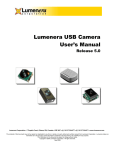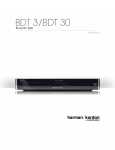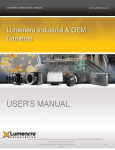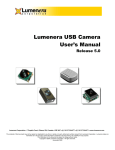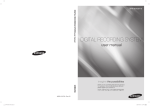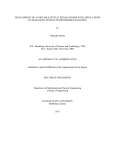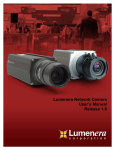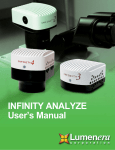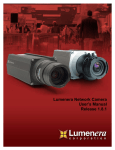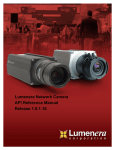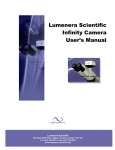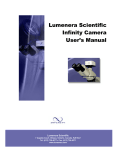Download Lumenera USB Camera User`s Manual
Transcript
Lumenera USB Camera
User’s Manual
Release 3.5
Lumenera USB Camera
User’s Manual
Release 3.5
The contents of this document may not be copied nor duplicated in any form, in whole or in part, without prior written
consent from Lumenera Corporation. Lumenera makes no warranties as to the accuracy of the information contained in
this document or its suitability for any purpose. The information in this document is subject to change without notice.
Copyright © 2004 Lumenera Corporation. All rights reserved.
Lumenera Corporation
Copyright 2004
2470 Don Reid Drive, Ottawa, Ontario, Canada. K1H 1E1
Tel: (613) 736-4077 • Fax: (613) 736-4071
www.lumenera.com
Page 1
Lumenera USB Camera
User’s Manual
Release 3.5
License Agreement (Software):
This Agreement states the terms and conditions upon which Lumenera
Corporation ("Lumenera") offers to license to you (the "Licensee") the software
together with all related documentation and accompanying items including, but
not limited to, the executable programs, drivers, libraries, and data files
associated with such programs (collectively, the "Software").
The Software is licensed, not sold, to you for use only under the terms of this
Agreement.
Lumenera grants to you the right to use all or a portion of this Software provided
that the Software is used only in conjunction with Lumenera's family of products.
In using the Software you agree not to:
a) decompile, disassemble, reverse engineer, or otherwise attempt to derive the
source code for any Product (except to the extent applicable laws specifically
prohibit such restriction);
b) remove or obscure any trademark or copyright notices.
Limited Warranty (Hardware and Software):
ANY USE OF THE SOFTWARE OR HARDWARE IS AT YOUR OWN RISK.
THE SOFTWARE IS PROVIDED FOR USE ONLY WITH LUMENERA'S
HARDWARE AND OTHER RELATED SOFTWARE. THE SOFTWARE IS
PROVIDED FOR USE "AS IS" WITHOUT WARRANTY OF ANY KIND. TO THE
MAXIMUM EXTENT PERMITTED BY LAW, LUMENERA DISCLAIMS ALL
WARRANTIES OF ANY KIND, EITHER EXPRESS OR IMPLIED, INCLUDING,
WITHOUT LIMITATION, IMPLIED WARRANTIES OR CONDITIONS OF
MERCHANTABILITY, QUALITY AND FITNESS FOR A PARTICULAR
PURPOSE. LUMENERA IS NOT OBLIGATED TO PROVIDE ANY UPDATES
OR UPGRADES TO THE SOFTWARE OR ANY RELATED HARDWARE.
Limited Liability (Hardware and Software):
In no event shall Lumenera or its Licensor's be liable for any damages
whatsoever (including, without limitation, incidental, direct, indirect, special or
consequential damages, damages for loss of business profits, business
interruption, loss of business information, or other pecuniary loss) arising out of
the use or inability to use this Software or related Hardware, including, but not
limited to, any of Lumenera's family of products.
Page 2
Copyright 2004
Lumenera USB Camera
User’s Manual
Release 3.5
Table of Contents
INTRODUCTION .........................................................................................................................5
1.1
THE LUMENERA USB CAMERA FAMILY ...........................................................................5
INSTALLING AND USING THE CAMERA ............................................................................6
2.1
SOFTWARE INSTALLATION ...............................................................................................6
2.1.1
Minimum System Requirements...............................................................................6
2.1.2
Installation Procedure.............................................................................................6
2.2
TECHNICAL SUPPORT........................................................................................................7
2.3
USING THE INSTALLED SOFTWARE ...................................................................................8
2.3.1
Drivers & INF .........................................................................................................8
2.3.2
DirectShow Filters...................................................................................................8
2.3.3
Application Software ...............................................................................................8
2.3.4
Development Software (SDK)..................................................................................9
2.3.5
Documentation ........................................................................................................9
2.4
USING LUCAM CAPTURE ..................................................................................................9
2.4.1
Menu Items ..............................................................................................................9
2.4.2
Buttons and Interface Controls .............................................................................11
UNDERSTANDING YOUR CAMERA ....................................................................................14
3.1
SHUTTER TYPES .............................................................................................................14
3.1.1
Rolling Shutter.......................................................................................................14
3.1.2
Half Global Shutter ...............................................................................................14
3.1.3
Global Shutter .......................................................................................................15
3.2
SCANNING MODE ...........................................................................................................16
3.2.1
Progressive Scan ...................................................................................................16
3.2.2
Interlaced Scan......................................................................................................16
3.3
USE OF FLASH OR STROBE ..............................................................................................17
3.3.1
Flash with Rolling Shutter.....................................................................................17
3.3.2
Flash with Half Global Shutter .............................................................................17
3.3.3
Flash with Global Shutter .....................................................................................18
3.4
CAMERA MODES ............................................................................................................18
3.4.1
Streaming Video ....................................................................................................18
3.4.2
Snapshot (Asynchronous Trigger).........................................................................18
3.5
DATA FORMAT ...............................................................................................................19
3.6
SUBWINDOWING, SUBSAMPLING & BINNING ..................................................................20
3.7
EXTERNAL I/O INTERFACE .............................................................................................21
3.7.1
Recommended Mating Connectors........................................................................21
3.7.2
Header Pin-out ......................................................................................................22
3.7.3
Signal Definitions ..................................................................................................22
3.7.4
Taking a Single-Frame Snapshot with the Camera...............................................23
3.8
EXTERNAL POWER..........................................................................................................24
Copyright 2004
Page 3
Lumenera USB Camera
User’s Manual
3.9
Release 3.5
LENS MOUNT ................................................................................................................. 24
APPLICATION PROGRAMMING INTERFACE USER’S GUIDE.................................... 25
4.1
GENERAL OVERVIEW ..................................................................................................... 25
4.2
BASIC TASKS .................................................................................................................. 25
4.2.1
Connecting and Disconnecting ............................................................................. 25
4.2.2
Query the Camera ................................................................................................. 26
4.2.3
Preview Video ....................................................................................................... 26
4.2.4
Adjusting the Video ............................................................................................... 26
4.2.5
Configuring Video Format .................................................................................... 27
4.2.6
Grab Video Data ................................................................................................... 27
4.2.7
Take a Snapshot (or many).................................................................................... 28
4.2.8
Processing Images................................................................................................. 28
4.2.9
Save Image to Disk ................................................................................................ 28
4.2.10
Setting and Getting Camera Properties ................................................................ 29
4.3
ADVANCED TASKS ......................................................................................................... 30
4.3.1
Manage Your Own Video Display Window........................................................... 30
4.3.2
Custom Color Correction Matrix.......................................................................... 30
4.3.3
Custom Look-Up-Tables ....................................................................................... 30
4.3.4
Video Callback functions ...................................................................................... 30
4.3.5
MultipleCamera, Simultaneous Image Capture.................................................... 31
4.3.6
Non-Volatile User Accessible Camera Memory ................................................... 31
Page 4
Copyright 2004
Lumenera USB Camera
User’s Manual
Release 3.5
1 1
Introduction
1.1
The Lumenera USB Camera Family
Lumenera USB Cameras provide a quick and easy means of displaying and
capturing high quality video and images on any USB 2.0 equipped desktop,
laptop or embedded computer.
Designed with flexibility in mind, each camera model has its own distinct
advantage over the others, whether speed, resolution, image quality, sensitivity
or price. Because they are USB based, there is no need for a frame grabber.
Instead, a single cable provides power, full command and control and data
transfer at speeds of up to 24 MB/s.
All cameras have a provision to be externally powered for cases where the USB
cable does not supply power (e.g. some USB cards on laptop computers.)
All cameras share the same simple, yet powerful API allowing easy migration
from one camera to another. Both board-level and enclosed cameras are
available. All cameras also have an optional external interface header for
hardware input and output signals and on-board memory for image buffering.
Copyright 2004
Page 5
Lumenera USB Camera
User’s Manual
Release 3.5
2
Installing and Using the Camera
2.1
Software Installation
The Lumenera USB 2.0 High-Speed camera you have just purchased is
designed to operate out of the box with minimal set-up.
Prior to plugging the camera into the computer, you must first install the
software.
The software can be found on the CD-ROM that shipped with your product.
2.1.1 Minimum System Requirements
•
Windows 2000 (Service Pack 3), or
•
Windows XP (Service Pack 1)
•
450 MHz Pentium III or higher (compatible)
•
128 MB RAM
•
USB 2.0 Port.
Note: A USB 2.0 Port is required. The camera will not work on a
standard USB1.1 port.
2.1.2 Installation Procedure
1. If you are using a 3rd party USB 2.0 PCI add-in card, please ensure the
add-in card is properly installed on your computer before proceeding. We
recommend that you use the built-in operating systems USB 2.0
EHCI drivers provided by Microsoft rather than the device drivers
supplied with your 3rd party card.
2. If you have purchased a developers kit and are using the supplied USB
2.0 PCI add-in card, the drivers are built-in when using Win XP with
Service Pack 1. Windows 2K users should first upgrade to Service Pack 3,
and then go to the Windows upgrade site:
http://windowsupdate.microsoft.com
to obtain the USB 2.0 Host controller drivers.
Page 6
Copyright 2004
Lumenera USB Camera
User’s Manual
Release 3.5
3. You must be logged into the computer with administrator privileges
prior to continuing the installation.
4. Close all application software that is running and then insert the Lumenera
Installer CD into your CD-ROM drive.
5. Wait a few moments for the auto-play function to run the installation
program automatically.
6. Follow the onscreen prompts to install the software drivers and user
application.
7. After the software has been installed, plug the USB 2.0 Camera into a free
USB 2.0 High-Speed port.
8. The Window’s New Hardware Wizard will pop-up detecting a new
“Lumenera Unconfigured Device”. Select Install the software
automatically from the options that are presented to you and click Next.
A warning may appear notifying you that the drivers have not been
digitally signed by Microsoft. Click Continue Anyway to continue with the
driver installation. Then click Finish to complete the installation of the
drivers.
9. After a few seconds the Window’s New Hardware Wizard will pop-up
again (if it doesn’t, disconnect and reconnect the camera to the computer),
detecting a “Lumenera USB 2.0 Camera” device. Select Install the
software automatically from the options that are presented to you and
click Next. A warning may appear notifying you that the drivers have not
been digitally signed by Microsoft. Click Continue Anyway to continue
with the driver installation. Then click Finish to complete the installation of
the drivers.
Note: Windows will require you to re-run steps 8 & 9 each
time you plug the camera into a new USB 2.0 port. You
must have administrator privileges the first time the camera
is used on any given USB 2.0 port. You may wish to repeat
the installation steps at this time for all USB 2.0 ports on
your computer.
10. Run the application software from your Start menu and enjoy!
2.2
Technical Support
If you have problems installing or using the software or with general camera
operation, you can e-mail our technical support group at:
[email protected]
Copyright 2004
Page 7
Lumenera USB Camera
User’s Manual
Release 3.5
To obtain the latest software release and other technical information you may
visit our technical support website at:
www.lumenera.com/tech.html
2.3
Using the Installed Software
All of the necessary software and device drivers are contained in an installation
program on the CD-ROM that comes with the camera.
The following files are installed when you run the installation program:
2.3.1 Drivers & INF
Files with a .sys extension are copied to …\SYSTEM32\DRIVERS folder in the
standard Windows folder on your system. There are two of these files for each
camera model supported by the software. The names of these files are
LucamXXX.sys and LuldrXXX.sys (the XXX represents the 3 digit camera ID
number.)
Files with a .inf extension are copied to …\INF folder in the standard Windows
folder of your system. There are up to two of these files for each camera model
supported by the software. The names of these files are LucamXXX.inf and
LuldrXXX.inf (the XXX represents the 3 digit camera ID number.)
2.3.2 DirectShow Filters
Several DirectShow related files are installed in the …\SYSTEM folder in the
standard Windows folder on your system. These files all have a .ax extension.
Their names are:
Lutf.ax
lucustom.ax
lustrcfg.ax
2.3.3 Application Software
The Lucam Capture application (Lucam.exe) is installed in the directory selected
during the installation process. The default location is:
C:\Program Files\Lumenera Corporation\Lucam Software
A shortcut to this application is added to the Start Menu at the location selected
during installation. The default location is:
Start > Programs > Lumenera > LuCam > Lucam.exe
Page 8
Copyright 2004
Lumenera USB Camera
User’s Manual
Release 3.5
2.3.4 Development Software (SDK)
If you purchased the Developer’s Kit, the Lucam Capture application source
code, and the API libraries are installed in folders called “Sample Code” and
“SDK”, which are in the directory selected during the installation process. The
default location is:
C:\Program Files\Lumenera Corporation\Lucam Software
The source code consists of a complete Microsoft Visual C++ 6.0 project. The
libraries are also compatible with Visual Basic and Borland C++ Builder.
2.3.5 Documentation
Documentation consisting of this User’s Manual, the API reference manual (if you
purchased the Developer’s Kit) and the latest available Application Notes and
White Papers, is installed in a folder called “Documentation” in the directory
selected during the installation process. The default location is:
C:\Program Files\Lumenera Corporation\Lucam Software
To obtain the latest documentation and other technical information you may visit
our technical support website at:
www.lumenera.com/tech.html
2.4
Using Lucam Capture
The Lucam Capture application is, for the most part, simple to use and selfexplanatory. The application makes use of the SDK and provides an example of
what the API can do, however, it doesn’t make use of all the available features of
the API. The complete source code for this application is available to those that
purchased the Developer’s Kit.
Only one camera may be controlled by each instance of Lucam Capture, but
several instances of the application may be run simultaneously. If more than one
camera is detected by the application, it pops up a list of their serial numbers,
allowing the user to select the camera they wish to control.
2.4.1 Menu Items
“Preview Frame Rate…” will display the average frame rate of the preview
window. The average is computed over the whole time span that the display has
been actively previewing since the last time Start Preview was pressed.
“Read/Write Registers…” will pop up a dialog allowing you to read and write
the registers of the camera. This is an advanced function and should not be
used without the advice of our technical support staff.
Copyright 2004
Page 9
Lumenera USB Camera
User’s Manual
Release 3.5
“Light/Source” provides the option of selecting the ambient lighting source that
is being used so that the proper colour correction can be performed by the
camera. These options have little effect for some cameras.
“Enable 16-bit Mode” will put the camera into 16-bit mode. You cannot preview
data in this mode; but the data will still stream to the computer (see Camera
Modes section below for more information about streaming) allowing you to
capture 16-bit video frames. (The number of actual valid data bits per pixel will
vary by camera model.)
“Monochrome Preview” puts the camera into monochrome mode.
“Image Averaging” averages 5 frames of video together to reduce random
image noise, when the Capture button is pressed. This option should not be
used when imaging a moving object.
“Image Summing” sums 5 frames of video together to produce a brighter
image, when the Capture button is pressed. This option should not be used
when imaging a moving object.
“Sharpen Captured Image” applies a sharpening algorithm to the image when
it’s captured (not the live preview). If an image is currently being displayed,
toggling this option will immediately toggle the image in the image display
window between sharpened and unsharpened.
“Hue/Saturation…” pops up a dialog that allows you to adjust the hue and
saturation of the live preview.
“Display Video Properties…” pops up a “canned” dialog generated by the
Lucam API that allows you to adjust video properties (Exposure, Gain, Gamma,
Brigtness, Contrast).
Page 10
Copyright 2004
Lumenera USB Camera
User’s Manual
Release 3.5
Figure 1 - Lucam Capture Main Window
2.4.2 Buttons and Interface Controls
The “Start Preview” button is used to start the video display to the screen.
The “Stop Preview” button is used to stop the video display to the screen.
Video Frame Capture
The “Capture” button is used to grab a frame of video from the video stream and
display it on screen.
The “Save As…” button is used to save the image to disk in one of the available
formats.
The “Hide View” button will close the image display window.
The “Capture & Save Bayer Data” toggle button allows you to view and save the
raw Bayer data that comes from the camera, before it is processed into 24-bit
RGB data. (Color cameras only.) If an image is currently being displayed (with
Copyright 2004
Page 11
Lumenera USB Camera
User’s Manual
Release 3.5
the Capture button), toggling this button will immediately toggle the image in the
image display window between Bayer and 24-bit data.
Video Image Control
The “Image Size” dropdown list provides the available video display resolutions.
The “Frame Rate” toggle buttons provide the selection of the available display
frame rates. Not all cameras have this capability.
The “Exposure” slider is used to adjust the video exposure time in milliseconds.
The “AEC” toggle button is used to toggle the Automatic Exposure Control (not
available for all cameras). When selected, the slider changes to “Luminance
Target” allowing you to select the average brightness that you want to maintain
as ambient lighting changes. The exposure will be automatically adjusted in an
attempt to maintain the average brightness.
The “Gain” slider is used to adjust the global gain of the camera for both video
mode and when using the Snapshot mode (described below). The gain value is
a multiplicative factor, so a value of 1 means no gain. When the gain is
increased, noise will be introduced in the camera and the image will be
degraded. The higher the gain, the more noticeable this is.
The “AGC” toggle button is used to toggle the Automatic Gain Control (not
available for all cameras). When selected, the slider changes to “Luminance
Target” allowing you to select the average brightness that you want to maintain
as ambient lighting changes. The gain will be automatically adjusted in an
attempt to maintain the average brightness.
Note: When both AEC and AGC are selected, if an increase in
brightness is required, exposure is adjusted up first until its limit is
reached and then gain is adjusted. When a decrease in brightness
is required, gain is adjusted down first until its limit is reached and
then exposure is adjusted. This maintains the best image quality.
The “Gamma” value is applied to the image to make it look better on screen. It is
used to correct the non-linearity inherent in most monitors. A value of 1
represents no gamma correction. Values less than one will make the image
appear darker and greater than one will make the image appear brighter. For
more information about Gamma and why it’s used, consult the following
reference: www.poynton.com/GammaFAQ.html
The “WB” button performs a color balance (a.k.a. white balance) of the video
preview, based on the overall image, using the gray world algorithm. It is done in
software by grabbing a video frame, analyzing it, adjusting the color gains and
repeating until the colors in the image are balanced. That is, there is an equal
amount of Red, Blue and Green in the image. It is best to put a neutral target
(e.g. white paper) in front of the camera before performing a color balance.
Page 12
Copyright 2004
Release 3.5
Lumenera USB Camera
User’s Manual
Snapshot Settings
The “Exposure” value is the length of time to expose the snapshot for in
milliseconds.
The “Snapshot” button is used to grab an image from the camera using its
snapshot mode and half-global or global shutter (if available), and display it on
screen. (see Shutter Types and Camera Modes sections below for more
information about snapshot mode and global shutter)
The “Hide View” button will close the snapshot image display window.
The “Wait for HW Input Trigger” toggle is used to specify that the snapshot
should be hardware triggered using the trigger input of the camera’s external
header. With this option selected, when the “Snapshot” button is pressed, the
software will pause as the camera waits for the hardware trigger before returning
the image. There is a built-in time-out of 25 seconds after which time if the
hardware trigger has not occurred, the software will resume operation.
The “Use Strobe Trigger” toggle is used to specify that during the snapshot
exposure, the strobe trigger output should be fired.
The “Trigger Delay” value indicates the time in milliseconds between the start of
exposure and the rising edge of the strobe trigger pulse.
The “Save As…” button is used to save the snapshot image to disk in one of the
available formats.
The “16 Bits per Pixel” toggles the camera between 8 and 16-bit data mode for
snapshot capture.
The “White Balance Gains for Strobe Snapshot” values allow you to set the
Red, Green and Blue gains to be used during the snapshot capture. This allows
you to white balance according to the strobe lighting that is being used. They are
only applied if the “Use Strobe Trigger” option is selected.
Copyright 2004
Page 13
Lumenera USB Camera
User’s Manual
Release 3.5
3
Understanding Your Camera
3.1
Shutter Types
Depending on which camera model you have, the following electronic shutter
types may or may not be present. Check the table at the end of this section to
determine which camera model has which shutter type. These types are
selectable for the snapshot mode of the camera (described in a later section).
3.1.1 Rolling Shutter
With a rolling shutter the exposure process begins, whereby, rows of pixels in the
image sensor start exposing in sequence, starting at the top of the image and
proceeding row by row down to the bottom. At some later point in time, the
readout process begins, whereby, rows of pixels are read out in sequence,
starting at the top of the image and proceeding row by row down to the bottom in
exactly the same manner and at the same speed as the exposure process.
The time delay between a row starting to expose and a row being read out is the
integration time, also known as the exposure time. This integration time can be
varied from a single line (start exposure followed by a read out while the next line
is exposing) up to a full frame time (last line starts exposing at the bottom of the
image before reading starts at the top). In some cases, longer exposures can be
obtained by delaying the read out even longer (during which time, the entire array
is exposing).
Since the integration process moves through the image over some length of time,
skewing of moving objects may become apparent. For example, if a vehicle is
moving through the image during capture, light from the top of the vehicle will be
integrated at some earlier time than light from the bottom of the vehicle, causing
the bottom of the vehicle to appear slanted forward in the direction of motion.
For most slow moving objects or still image capture, this motion artifact is not
noticeable.
3.1.2 Half Global Shutter
With a half global shutter, the entire image array starts exposing at the same time
(globally). At some later point in time, the readout process begins, whereby;
Page 14
Copyright 2004
Lumenera USB Camera
User’s Manual
Release 3.5
rows of pixels are read out in sequence, starting at the top of the image and
proceeding row by row down to the bottom (exactly like the rolling shutter case).
The time between the global start of integration and the start of readout is
defined as the exposure time. However, since during readout of the image, the
lines are still integrating (like rolling shutter), the actual image exposure differs
from the top to the bottom. The difference is the time taken to readout the image
and varies for each camera (70 ms is typical). Under bright ambient lighting
conditions, the image will appear brighter; the further down the image you go.
Because integration continues to occur during readout, the skewing motion
artifact can still occur.
3.1.3 Global Shutter
With a global shutter, the entire image array starts exposing at the same time
(globally). At some later point in time, the entire image array stops exposing at
the same time and the image is read out in sequence, starting at the top of the
image and proceeding row by row down to the bottom (sometimes odd rows are
read out first followed by the even rows). The difference from the other modes is
that during readout, the imager is no longer integrating light.
The time delay between the start of exposure and end of exposure is defined as
the exposure time and it represents the total amount of time that the image
integrates.
Because all the pixels start exposure at the same time, integrate over the same
interval, and stop exposing at the same time, there is no potential for motion
artifacts as there is in the other modes.
Table 1 - Shutter Types by Camera Model
Camera Model
Rolling Shutter
Half Global Shutter
Global Shutter
LU-050, LU-055
LU-070, LU-075
LU-080, LU-085
LU-100, LU-105
LU-110, LU-115
LU-120, LU-125
LU-130, LU-135
LU-160, LU-165
LU-170, LU-175
LU-200, LU-205
LU-270, LU-275
LU-330, LU-335
Yes
No
No
Yes
Yes
Yes
No
No
Yes
Yes
Yes
No
No
No
No
Yes
No
No
No
No
No
Yes
No
No
Yes
Yes
Yes
No
No
Yes
Yes
Yes
No
No
No
Yes
Copyright 2004
Page 15
Lumenera USB Camera
User’s Manual
Release 3.5
Yes
Yes
LU-370, LU-375
LU-620, LU-625
3.2
No
No
No
No
Scanning Mode
Depending on which model of camera you have, the frame integration will be
either progressive scan or interlaced. Check the table at the end of this section
to determine which camera model has which scan type.
3.2.1 Progressive Scan
In a progressive scan camera, the entire image is integrated (exposed) at one
point in time (for global shutters) or line-by-line from top to bottom (for rolling
shutters).
3.2.2 Interlaced Scan
In an interlaced scan camera, the entire image is made up of two fields. Each
field is made up of the odd lines of the image (odd field) or the even lines of the
image (even field). Each field is captured in a progressive manner (using a
global shutter), but the exposure for the second field is started after the first one
is read out.
When there is no movement of the object being viewed, you will not see a
difference between progressive and interlaced scan images. However, when
there is movement of the object, the interlaced scan image will exhibit image
artefacts known as the “comb” effect where the edges of the object look like the
teeth of a comb because the object is in a different place for the odd versus the
even rows of the image.
Table 2 - Scan Mode by Camera Model
Page 16
Camera Model
Scan Mode
LU-050, LU-055
LU-070, LU-075
LU-080, LU-085
LU-100, LU-105
LU-110, LU-115
LU-120, LU-125
LU-130, LU-135
LU-160, LU-165
LU-170, LU-175
Progressive
Progressive
Progressive
Progressive
Progressive
Progressive
Progressive
Progressive
Progressive
Copyright 2004
Lumenera USB Camera
User’s Manual
Release 3.5
LU-200, LU-205
LU-270, LU-275
LU-330, LU-335
LU-370, LU-375
LU-620, LU-625
3.3
Progressive
Progressive
Interlaced
Progressive
Progressive
Use of Flash or Strobe
A flash or strobe may be used with any camera model and the option is available
to provide a programmable trigger signal from the camera to the flash or strobe
device to tell it when to fire. However, the type of shutter mode being used will
dictate what conditions will be required and how well flash photography will work
with the camera.
3.3.1 Flash with Rolling Shutter
The use of a flash with rolling shutter is only feasible for cameras that allow
exposures longer than frame read out time (typically about 70 ms). This is
because with exposures less than that, only a band across the imager is being
exposed at the same point in time and when the flash occurs, it will only
illuminate that region of the imager. The flash must be fired at the time when all
the pixels of the imager are simultaneously sensitive to light. The strobe signal
from the camera is generated at a user selectable delay from that point in time.
Generally, the ambient lighting should be low enough (i.e. dark) so that during
the overall exposure the ambient light will not contribute much to the overall
brightness of the image. This is particularly true if the flash is being used to “stop
the motion” of a fast-moving object, otherwise, blurring or skewing may occur.
For imaging still objects, this is not as much of a concern. In this case, you only
need to ensure that you are not overexposing the object with both a long
exposure and a flash.
3.3.2 Flash with Half Global Shutter
The use of a flash or strobe with an imager using a half global shutter is similar to
the rolling shutter case. However, because the imager starts at once exposing
all the pixels globally, the strobe signal from the camera is generated at a user
selectable delay from the start of exposure. It doesn’t have to first wait for the
rolling shutter to “open up” all the way, like for rolling shutter mode.
Again, the ambient lighting should be low enough so that during the image read
out where the imager is still sensitive, the ambient light will not contribute much
to the overall brightness of the image. This is a concern for both moving objects
where both blurring and skewing may occur, and still objects where you may
Copyright 2004
Page 17
Lumenera USB Camera
User’s Manual
Release 3.5
have uneven brightness from the top of the image to the bottom (as described in
the previous section.)
3.3.3 Flash with Global Shutter
The use of a flash or strobe with a global shutter has no limitations or concerns.
The strobe signal from the camera is generated at a user selectable delay from
the start of the exposure. Very short, global exposures can be used, so, there
will be no blurring or skewing or overexposure due to long exposures.
3.4
Camera Modes
The camera has two operating modes: Streaming Video, and Snapshot.
3.4.1 Streaming Video
In streaming video mode, image frames are continuously being sent from the
camera to the computer where they are available for use. The data is pushed
from the camera, with no user intervention required. The rolling shutter is always
used in this mode. An output signal is provided on the external header indicating
the start of exposure for each video frame and can be used to help synchronize
events with the video images. The camera will operate with the fastest frame
rates in this mode.
3.4.2 Snapshot (Asynchronous Trigger)
Snapshot mode is used to capture one (or more) individual frames in an
asynchronous manner. In this mode, the user must initiate the action to start the
image retrieval through either hardware or software.
The software trigger is provided using API function calls. The function call is
made causing the snapshot to be taken and a single image is returned.
The hardware input trigger (with a user programmable delay) can be used to
initiate the snapshot via the external I/O interface. An API function call is made
that puts the camera into this “wait for hardware trigger” state and then “blocks”
until the hardware trigger is received. Once the trigger is received (or the user
selected timeout occurs), the API function returns and passes back the image (or
a timeout error code).
Any of the available shutter types can be used with snapshot mode. An output
strobe signal with programmable delay can also be synchronized with each
snapshot. This is described in more detail in the “External I/O Interface” section
below.
Because the snapshot mode is initiated for each image that is desired and
images are buffered inside the camera, the amount of time it takes to grab a
Page 18
Copyright 2004
Lumenera USB Camera
User’s Manual
Release 3.5
single snapshot is about twice the time for each streaming video image.
Therefore, the effective frame rate is about half of the maximum video frame rate.
3.5
Data Format
Data from the camera can be retrieved in one of two pixel formats. These
formats represent the bit depth in bits per pixel [bpp]. Either 8 bpp or 16 bpp can
be selected. For 16 bpp, not all of the bits are necessarily valid data bits.
Depending on the camera model, 10, 12 or 14 bits will be valid data, with the
other 6, 4, or 2 bits always zero. A completely dark pixel will have all valid bits
set to zero and a completely light-saturated pixel will have all valid bits set to one.
The valid data bits are stored most significant bit aligned in each word and the
words are in Little Endian byte order (least significant byte is first of each byte
pair). The following table illustrates this point where the data for the first three
pixels (completely light-saturated) of an image are represented.
Table 3 - Pixel Data Format for 16 bpp (10 valid data bits)
Pixel
16-bit Word
Byte Order
Binary value
Hex value
Decimal value
Pixel 1
Pixel 2
Pixel 3
Word 1
Word 2
Word 3
Byte 1
Byte 2
Byte 3
Byte 4
Byte 5
Byte 6
LSB
MSB
LSB
MSB
LSB
MSB
11000000 11111111 11000000 11111111 11000000 11111111
0xC0
0xFF
0xC0
0xFF
0xC0
0xFF
192
255
192
255
192
255
For monochrome cameras, each byte (8bpp) or word (16bpp) represents one
complete pixel in the image.
For color cameras, the data arrives from the camera in the raw Bayer format.
The imager in a color camera is a monochrome imager that has a Red, Green or
Blue color filter over each pixel. The arrangement of this color filter mosaic is
called the Bayer format. An example of this can be seen in Figure 1.
Figure 2 - Example of a 6x6 Pixel Area of Color Imager Mosaic Pattern
Copyright 2004
Page 19
Lumenera USB Camera
User’s Manual
Release 3.5
Each byte (8bpp) or word (16bpp) will be one of the three mosaic colors: Red,
Green or Blue. The order of these colors is camera model dependent and can
be found in the following Table.
Table 4 - Bayer Data Color Mosaic Order
Camera Model
LU-050, LU055
LU-070, LU-075
LU-080, LU-085
LU-100, LU-105
LU-110, LU-115
LU-120, LU-125
LU-130, LU-135
LU-160, LU-165
LU-170, LU-175
LU-200, LU-205
LU-270, LU-275
LU-330, LU335
LU-370, LU-375
LU-620, LU-625
Pixel 1 Row 1
Red
Red
Green 1
Blue
Green 1
Green 1
Red
Red
Green 1
Blue
Green 1
Red
Green 1
Red
Mosaic Order
Pixel 2 Row 1 Pixel 1 Row 2
Green 1
Green 2
Green 1
Green 1
Red
Blue
Green 1
Green 2
Red
Blue
Blue
Red
Green 1
Green 2
Green 1
Green 2
Red
Blue
Green 1
Green 2
Red
Blue
Green 1
Green 2
Red
Blue
Green 1
Green 1
Pixel 2 Row 2
Blue
Blue
Green 2
Red
Green 2
Green 2
Blue
Blue
Green 2
Red
Green 2
Blue
Green 2
Blue
When using the Lucam Capture application to preview video from a color camera
or save images to disk, conversion of the data to standard 24-bit RGB data is
done by the software automatically.
When using the API (available with the Developer’s Kit), you have complete
control over this conversion process.
3.6
Subwindowing, Subsampling & Binning
Subwindowing, also known as region of interest, is the ability of the camera to
output a smaller image size (subwindow) than the whole imager array. An
imager that supports a maximum resolution of 1280x1024 pixels for example,
could output a subwindow of 640x480 pixels with the subwindow being
positioned nearly anywhere inside the 1280x1024. The subwindow is actually a
smaller field of view than the maximum resolution available. There are limitations
on the granularity of the subwindow size and on its position within the whole
array. The granularity is 8 pixels.
Subsampling, also known as decimation, is the throwing away of every nth pixel
or pixel pair in the image in the X and/or Y directions. For example, an imager
Page 20
Copyright 2004
Lumenera USB Camera
User’s Manual
Release 3.5
with a maximum resolution of 1280x1024 could throw away every second pixel in
both the X and Y directions and output an image that is 640x512 pixels, yet
covers the same field of view of the original full resolution. Not all cameras
support Subsampling. Those that do may support subsample levels of 2, 4 or 8.
Some cameras even allow different Subsampling in the X vs. the Y directions.
Binning is similar to Subsampling, except instead of throwing pixels away pixels
are combined in some fashion. They can be either summed (to provide greater
sensitivity) or averaged (to reduce noise). The resulting resolution would be the
same as for Subsampling, but all the data would be used. Several cameras
support binning with binning levels up to 8 by 8.
3.7
External I/O Interface
For board-level cameras, the External Interface Header can be found in the
corner of the PCB next to the silver USB connector. For enclosed cameras, it is
found on the side of the camera near the USB connector. It is a male, 2 mm
pitch, 16-pin (2 x 8) header. The pin numbering can be seen in Figure 2.
Figure 3 - External Header Location and Pin Numbering
3.7.1 Recommended Mating Connectors
The following mating connectors have been tested to work with the cameras. All
of them are for 16-pin (2 x 8), 2mm pitch headers.
•
•
•
•
AMP/Tyco P/N 111623-3 IDC Ribbon Cable Receptacle
Molex GC/Waldom P/N 87568-1661 IDC Ribbon Cable Receptacle
Molex GC/Waldom P/N 87568-1691 IDC Ribbon Cable Receptacle Locking
Molex GC/Waldom 51110-1650 Wire Crimp Receptacle
o Female Crimp Terminal for above – P/N 50394-8100
Copyright 2004
Page 21
Lumenera USB Camera
User’s Manual
•
•
Release 3.5
Norcomp P/N 2064-16-01-P2 Vertical Dual Row Receptacle
Sullins P/N PPWN082AFCN Vertical Dual Row Receptacle
All of these connectors can be purchased from Digi-Key® (www.digikey.com) but
other parts suppliers may also carry them.
3.7.2 Header Pin-out
Table 5 - Header Pin-out Definition
SIGNAL
GPO1 / Strobe Out (AL)
GPO2 / Strobe Out (AH)
GPO3
GPO4 / Video SOF
GPI1 / Trigger In
GPI2
GPI3
GPI4
PIN #
1
3
5
7
9
11
13
15
PIN #
2
4
6
8
10
12
14
16
SIGNAL
GND
GND
GND
GND
GND
GND
GND
GND
None of the signals can supply much current. Maximum current draw should be
kept to less than 5 mA.
3.7.3 Signal Definitions
GPO1 / Strobe Out: Pin 1, LVTTL output (Voh ~ 3.0V, Vol ~ 0V). This signal can
be toggled using the LucamGPIOWrite function of the API.
This signal serves double duty and is also used to provide an ACTIVE LOW, 5.5
ms pulse (suitable for triggering a strobe unit) when any of the “Take Snapshot”
API functions are used with the “useStrobe” option enabled. This strobe pulse
can be delayed with respect to the start of frame exposure by a user selectable
amount (see “Lumenera API Reference Manual” for further details).
GPO2 / Strobe Out: Pin 3, LVTTL output (Voh ~ 3.0V, Vol ~ 0V). This signal can
be toggled using the LucamGPIOWrite function of the API.
This signal serves double duty and is also used to provide an ACTIVE HIGH, 5.5
ms pulse (suitable for triggering a strobe unit) when any of the “Take Snapshot”
API functions are used with the “useStrobe” option enabled. This strobe pulse
can be delayed with respect to the start of frame exposure by a user selectable
amount (see “Lumenera API Reference Manual” for further details).
GPO3: Pin 5, LVTTL output (Voh ~ 3.0V, Vol ~ 0V). This signal can be toggled
using the LucamGPIOWrite API function.
GPO4 / Video SOF: Pin 7, LVTTL output (Voh ~ 3.0V, Vol ~ 0V). This signal can
be toggled using the LucamGPIOWrite API function.
Page 22
Copyright 2004
Release 3.5
Lumenera USB Camera
User’s Manual
This signal serves double duty and is also used to provide an ACTIVE HIGH, 85
us pulse each time a frame is output in video mode. The LucamGpoSelect API
function is used to enable/disable the Video SOF signal.
GPI1 / Trigger In: Pin 9, LVTTL input (Vin min = 0V, Vin max = 3.3V). This signal
is floating and MUST be driven at all times when being used. The signal status
can be obtained by using the LucamGPIORead API function.
This signal serves double duty and is also used to receive an ACTIVE HIGH,
LVTTL input (Vin min = 0V, Vin max = 3.3V) pulse which will trigger the taking of a
snapshot, when any of the “Take Snapshot” API functions are used with the
“useHwTrigger” option enabled. The active high pulse must have a minimum
width of 0.5 us. There is no maximum limit to the trigger pulse width.
GPI2: Pin 11, LVTTL input (Vin min = 0V, Vin max = 3.3V). This signal is floating
and MUST be driven at all times when being used. The signal status can be
obtained by using the LucamGPIORead API function.
GPI3: Pin 13, LVTTL input (Vin min = 0V, Vin max = 3.3V). This signal is floating
and MUST be driven at all times when being used. The signal status can be
obtained by using the LucamGPIORead API function.
GPI4: Pin 15, LVTTL input (Vin min = 0V, Vin max = 3.3V). This signal is floating
and MUST be driven at all times when being used. The signal status can be
obtained by using the LucamGPIORead API function.
3.7.4 Taking a Single-Frame Snapshot with the Camera
The Lumenera API makes use of several of the External Interface Header pins
automatically, when the “Take Snapshot” related functions (those that use the
LUCAM_SNAPSHOT structure) are called with certain options (see the API
documentation for more details.) The LUCAM_SNAPSHOT structure allows the
setting of the following parameters that control the taking of a snapshot and the
timing of triggers:
Trigger Mode (useHwTrigger): There are two types of snapshot triggering,
hardware and software. When enabled, the snapshot will be triggered when the
trigger input signal is detected after a “Take Snapshot” API is called (the API
blocks until it times out or until the trigger occurs and the frame of data is
returned). When disabled, the API function itself triggers the snapshot and
returns the frame of data. The hardware trigger is expected on Pin 9 of the
External Interface Header as described above. The software trigger is initiated
from within the API “Take Snapshot” functions (for more details see the API
documentation.)
Trigger Delay (exposureDelay): A delay in milliseconds from the trigger
(hardware or software) to the start of frame exposure can be set from 0 to 10.8
ms, in 42.6 us increments. The minimum delay from the trigger input, to the start
of exposure, is 0.8 us, with an error of ± 0.25 us.
Copyright 2004
Page 23
Lumenera USB Camera
User’s Manual
Release 3.5
Strobe Mode (useStrobe): In concert with either triggering mode, a user may
also trigger an external strobe light synchronized to the frame exposure. When
this parameter is enabled, the strobe signal pulse will be initiated on Pins 1 and 3
as described above. In this case, a strobe delay should be defined.
Strobe Delay (strobeDelay): A delay in milliseconds from the trigger (hardware
or software) to the strobe pulse (rising edge for ACTIVE HIGH, falling edge for
ACTIVE LOW) can be set from 0 to 10.8 ms, in 42.6 us increments.
Exposure Time (exposure): The length of time in milliseconds to expose the
image before readout begins. The exposure can be set from 0 to 2.3 seconds, in
42.6 us increments.
3.8
External Power
The camera is normally powered via the USB cable, which nominally supplies 5
Volts. A power adapter can also be used to power the camera, in cases where
the USB cable does not supply power (e.g. from a Laptop computer or nonpowered USB hub.)
The external power adapter must adhere to the following specifications:
1. 6 Volts DC Regulated
2. 1000 mA Minimum Current Rating
3. 2.1 mm tip
4. Center positive (+)
3.9
Lens Mount
The camera is equipped with an industry standard C-Mount lens mount.
Page 24
Copyright 2004
Lumenera USB Camera
User’s Manual
Release 3.5
4
Application Programming Interface
User’s Guide
4.1
General Overview
The API is composed of various functions that are used to control the camera,
query its state and acquire data from it. There are two groups of functions,
namely, a basic group and an advanced group.
The functions in the basic group are very simple to understand and use, and the
majority of an application’s functionality can be realized quickly using only these
functions.
The functions of the advanced group are more powerful and provide greater
flexibility and tighter control over the camera’s operation; however, they require a
more in-depth understanding of the inner workings of the camera. This
understanding can be gained from the information in the previous sections. If
you have questions that are not covered in this manual, you can e-mail technical
support group at:
[email protected]
The following section provides guidance for performing specific and common
tasks using the API. The source code provided with the Developer’s Kit contains
concrete examples of these tasks. For details and further information about
calling specific API functions, see the Lumenera USB Camera API Reference
Manual.
4.2
Basic Tasks
4.2.1 Connecting and Disconnecting
In order to communicate with a camera you must first open a connection to it and
obtain its handle. This handle is used as an input parameter to most of the other
API functions. The function used for this task is LucamCameraOpen. When
Copyright 2004
Page 25
Lumenera USB Camera
User’s Manual
Release 3.5
you are completely finished with the camera, you should terminate the
connection using LucamCameraClose.
Multiple cameras may be attached to the computer at one time. You can obtain
the number of cameras attached prior to connecting with any of them using the
LucamNumCameras function. The LucamEnumCameras function can be
used to obtain the unique serial numbers and camera type for all cameras
attached to the computer. Thus, it is possible for a specific camera to be
opened.
4.2.2 Query the Camera
Several functions exist to obtain information about the camera. To obtain the
version information for the camera, its driver and the API, you can use the
LucamQueryVersion function.
To determine the USB connection type (e.g. USB2.0 or USB1.1) you can call
LucamQueryExternInterface.
To determine the available frame rates for the camera you can use the
LucamEnumAvailableFrameRates function.
4.2.3 Preview Video
After a camera has been opened, a video preview can be displayed simply by
calling LucamStreamVideoControl. This function takes three parameters; 1)
the handle to the camera, 2) a control flag (set to START_DISPLAY) and, 3) a
window handle (if NULL a window is automatically created for the video display).
More advanced applications may wish to create their own display window. The
handle to this window can be passed to the function and the video will be
previewed in it.
Pausing or stopping the preview can be achieved using the same function with
the control flag set to PAUSE_STREAM or STOP_STREAMING. When the
video stream is stopped, the display window is removed (unless you have
created your own display window.)
While video is previewing, the displayed frame rate can be obtained using the
function LucamQueryDisplayFrameRate.
4.2.4 Adjusting the Video
The API allows for the simple adjustment of several of the video properties by
providing the ability to pop up one of two pre-defined dialogs. These dialogs are
based on the DirectShow libraries. LucamDisplayPropertyPage will pop up a
dialog for adjusting image properties (exposure, gain, etc.)
LucamDisplayVideoFormatPage will pop up a dialog for adjusting the video
format (resolution, pixel bit depth, etc.)
Page 26
Copyright 2004
Release 3.5
Lumenera USB Camera
User’s Manual
4.2.5 Configuring Video Format
At any time when the camera is not streaming video, you can configure the video
format using the LucamSetFormat function. This will allow you to select the
following video properties:
1. Subwindow size
2. Subwindow position
3. Subsampling
4. Pixel Format
5. Video Frame Rate
There are some constraints and limitations on and associated with the above
properties.
1. The subwindow size is provided as the window width and height. Both the
width and height must be a multiple of 8.
2. The subwindow position is provided as the x and y coordinates of the top
left corner of the subwindow. Both x and y must be multiples of 8.
3. Subsampling must be the same for both x and y directions and is limited to
2x2 or 4x4.
4. The Pixel Format is provided as LUCAM_PF_8 or LUCAM_PF_16 and
indicates the bit depth of the data. Using LUCAM_PF_16 doubles the
amount of data coming from the camera and will cause the maximum
frame rate to be cut in half. Although there are 16 bits per pixel in this
mode, only 10, 12, or 14 bits of data are valid (depending on the maximum
bit depth of the particular camera being used.)
5. The video frame rate provided may not be exactly as requested. The
closest smaller available rate will be provided.
4.2.6 Grab Video Data
As long as video streaming is turned on (with the LucamStreamVideoControl
function), video data can be grabbed from the camera. The function to use for
this is LucamTakeVideo. The number of frames must be specified as well as a
pointer to a buffer that will accept the data. The data returned from the camera is
in its raw form with each byte (for LUCAM_PF_8) or word (for LUCAM_PF_16)
returned from the camera representing a single pixel in the image. For color
cameras, the data is still in the Bayer format as described in a previous section.
It’s not necessary to be previewing the data to capture it. Grabbing video while
the preview is turned off is much more efficient and leaves the CPU free to do
other processing tasks.
Copyright 2004
Page 27
Lumenera USB Camera
User’s Manual
Release 3.5
4.2.7 Take a Snapshot (or many)
Single snapshots can be taken using one of several functions. The
LucamTakeSnapshot function can be used any time a camera is open to
asynchronously take a single snapshot using the camera’s snapshot mode.
Even if the camera is streaming video, the function will handle the stream,
stopping and then restarting it as necessary. The overhead associated with
managing the stream means this function is not extremely fast. However, it is a
very simple way to obtain snapshots when time is not critical.
For quicker snapshot capturing, individual functions exist to enable the snapshot
mode (LucamEnableFastFrame), take snapshots (LucamTakeFastFrames)
and then disable the snapshot mode (LucamDisableFastFrames) separately.
The use of these functions helps eliminate overhead associated with managing
the streaming video mode. When the Enable function is called, streaming is
stopped, and then snapshots can be captured repeatedly at a faster rate than
with LucamTakeSnapshot.
As with the “TakeVideo” functions, the data returned from the camera is in its
raw, unprocessed form.
4.2.8 Processing Images
For monochrome cameras, the data that arrives from the camera is ready for
user processing, display or capture to disk.
Data from color cameras, on the other hand, is in the raw Bayer format and will
typically need to be converted to 24-bit RGB before being user processed,
displayed or captured to disk. This conversion can be accomplished using the
LucamConvertFrameToRgb24 function.
The two additional functions LucamConvertFrameToRgb32 and
LucamConvertFrameToRgb48 are available to convert the raw Bayer data into
32 and 48-bit RGB data respectively.
The LucamConvertBmp24ToRgb24 function will convert the byte order for each
pixel from .bmp file standard Blue, Green, Red to Red, Green, Blue.
The color data can also be converted to 8-bit and 16-bit monochrome
(Greyscale) using the LucamConvertFrameToGreyscale8 and
LucamConvertFrameToGreyscale16 respectively.
4.2.9 Save Image to Disk
Saving images to disk can be accomplished with the LucamSaveImage or
LucamSaveImageW functions. Once a frame of data has been taken from the
camera (video or snapshot) it can be saved in one of several image formats.
(For color cameras, first convert to 24-bit RGB to obtain a proper color image.)
The available formats are:
1. Raw Data (.raw) - no header, no compression
Page 28
Copyright 2004
Lumenera USB Camera
User’s Manual
Release 3.5
2.
3.
4.
5.
Bitmap (.bmp) – Windows bitmap file
TIFF (.tif) – Tagged Image File Format
JPEG (.jpg) – JPEG compression
PNG (.png) – Portable Network Graphics Format
4.2.10 Setting and Getting Camera Properties
Camera properties are items such as exposure, gain, contrast, etc. There are
only three functions associated with camera properties. LucamSetProperty is
used to set the value of a camera property. LucamGetProperty is used to get
the value of a camera property. LucamPropertyRange will return the valid
range and default value for a given camera property. It is important to note that
not all properties are available for every camera supported by the API. The table
below indicates which properties are available for each camera model.
Table 6 - Property Availability By Camera Model
Property
Brightness
Contrast
Hue
Saturation
Sharpness
Gamma
Exposure
Gain
Red Gain
Blue Gain
Green1 Gain
Green2 Gain
Property
Brightness
Contrast
Hue
Saturation
Sharpness
Gamma
Exposure
Gain
Red Gain
Blue Gain
Green1 Gain
Copyright 2004
LU-050
LU-070
LU-080
LU-100
LU-110
LU-120
LU-130
Yes
Yes
Yes
Yes
No
Yes
Yes
Yes
Yes
Yes
Yes
Yes
Yes
Yes
Yes
Yes
No
Yes
Yes
Yes
Yes
Yes
Yes
Yes
Yes
Yes
Yes
Yes
No
Yes
Yes
Yes
Yes
Yes
Yes
Yes
Yes
Yes
Yes
Yes
No
Yes
Yes
Yes
Yes
Yes
No
No
Yes
Yes
Yes
Yes
No
Yes
Yes
Yes
Yes
Yes
Yes
Yes
Yes
Yes
Yes
Yes
No
Yes
Yes
Yes
Yes
Yes
Yes
Yes
Yes
Yes
Yes
Yes
No
Yes
Yes
Yes
Yes
Yes
Yes
Yes
LU-160
LU-170
LU-200
LU-270
LU-330
LU-370
LU-620
Yes
Yes
Yes
Yes
No
Yes
Yes
Yes
Yes
Yes
Yes
Yes
Yes
Yes
Yes
No
Yes
Yes
Yes
Yes
Yes
Yes
Yes
Yes
Yes
Yes
No
Yes
Yes
Yes
Yes
Yes
No
Yes
Yes
Yes
Yes
No
Yes
Yes
Yes
Yes
Yes
Yes
Yes
Yes
Yes
Yes
No
Yes
Yes
Yes
Yes
Yes
Yes
Yes
Yes
Yes
Yes
No
Yes
Yes
Yes
Yes
Yes
Yes
Yes
Yes
Yes
Yes
No
Yes
Yes
Yes
Yes
Yes
Yes
Page 29
Lumenera USB Camera
User’s Manual
Green2 Gain
4.3
Release 3.5
Yes
Yes
No
Yes
Yes
Yes
Yes
Advanced Tasks
4.3.1 Manage Your Own Video Display Window
When the LucamStreamVideoControl is used to start previewing video data,
the window is created automatically. Using LucamCreateDisplayWindow you
can create your own display window and specify its size and location on the
screen.
4.3.2 Custom Color Correction Matrix
For color cameras, the data returned from the camera is in the Bayer format.
However, this data needs to be color corrected to obtain true color. Normally,
one of the standard matrices would be selected from the available ones in the
API, but there may be instances where a custom matrix is desired. For example,
a color image can be converted to monochrome with the appropriate matrix.
Changing the Hue and Saturation can also be performed using a custom matrix.
In order to apply a custom matrix, it must first be defined. This is done using the
LucamSetupCustomMatrix function. To make use of this custom matrix in
video mode, you set the LUCAM_PROP_CORRECTION_MATRIX property to
LUCAM_CM_CUSTOM using LucamSetProperty. If you want the custom
matrix to be used when converting raw images from the camera to RGB24 using
LucamConvertFrameToRgb24, set the CorrectionMatrix field of the
LUCAM_CONVERSION structure to LUCAM_CM_CUSTOM.
4.3.3 Custom Look-Up-Tables
The camera has a built-in 8-bit LUT, which is used by the Brightness, Contrast
and Gamma properties. You can provide your own customized LUT, which will
be applied to all data coming from the camera, using the LucamSetup8bitsLUT
function. If you provide your own LUT, the Brightness, Contrast and Gamma
properties should not be used; otherwise they will overwrite the custom LUT.
4.3.4 Video Callback functions
The Video Callback feature allows you to supply your own function that will be
called for every frame of data that arrives from the camera, giving you access to
the data stream for frame-by-frame processing. This can be used to provide a
graphic overlay, for example, or false color to a monochrome image etc.
There are two functions that can be used to register your callback. The first is
named LucamAddStreamingCallback. The second is named
LucamAddRgbPreviewCallback. The only difference between them is the data
format of the frame of data that is passed to them. The first function will be
Page 30
Copyright 2004
Release 3.5
Lumenera USB Camera
User’s Manual
passed the raw data as it comes out of the camera. The second function will be
passed the data after it has been processed into RGB data. (For monochrome
cameras, there will be no difference between the data passed for either function.)
The LucamQueryRgbPreviewPixelFormat function can be used to determine
the bit depth of the RGB data (either 24 bpp or 32 bpp).
The callback function can be removed using either
LucamRemoveStreamingCallback or LucamRemoveRgbPreviewCallback
depending on which function was used to add it.
4.3.5 MultipleCamera, Simultaneous Image Capture
Several cameras can be connected to the same computer and used to capture
an image at the same time. This is accomplished using a set of three API
functions. LucamEnableSynchronousSnapshots enables this mode for all the
cameras. LucamTakeSynchronousSnapshots is used to perform the snapshot
capture. LucamDisableSynchronousSnapshots is used to disable this mode
for all the cameras.
4.3.6 Non-Volatile User Accessible Camera Memory
The camera contains a 1024-byte area of non-volatile memory that is useraccessible. The LucamPermanentBufferWrite function can be used to write
arbitrary data to the memory area that won’t get erased when the camera is
powered down. The LucamPermanentBufferRead function can be used to
read the memory area. There is a limit of 100,000 times that the memory area
can be overwritten reliably.
Copyright 2004
Page 31































